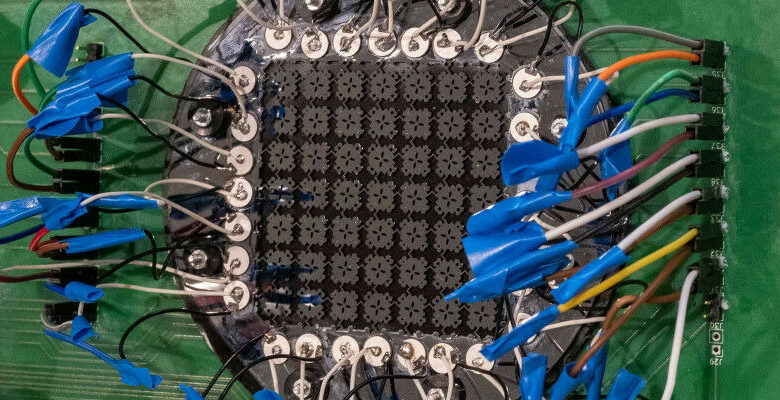Tone-powered sensors be on one?s feet to avoid wasting tens of millions of batteries

Researchers at ETH Zurich have evolved a sensor that utilises power from tone waves to keep watch over digital units. This would one age save tens of millions of batteries.
Sensors that track infrastructure, reminiscent of bridges or constructions, or are impaired in clinical units, reminiscent of prostheses for the deaf, require a relentless provide of energy. The power for this typically comes from batteries, that are changed once they’re blank. This creates a profusion misspend sickness. An EU find out about forecasts that during 2025, 78 million batteries will finally end up within the garbage each and every age.
A pristine form of mechanical sensor, evolved via researchers led via Marc Serra-Garcia and ETH geophysics tutor Johan Robertsson, may now serve a treatment. Its creators have already carried out for a patent for his or her invention and feature now introduced the main within the magazine Complicated Useful Fabrics.
Sure tone waves purpose the sensor to vibrate
“The sensor works purely mechanically and doesn’t require an external energy source. It simply utilises the vibrational energy contained in sound waves,” Robertsson says.
Every time a definite commitment is spoken or a specific sound or noise is generated, the tone waves emitted – and most effective those – purpose the sensor to vibrate. This power is nearest ample to generate a slight electric pulse that switches on an digital software that has been switched off.
The prototype that the researchers evolved in Robertsson’s lab on the Switzerland Innovation Soil Zurich in Dübendorf has already been patented. It may well distinguish between the spoken phrases “three” and “four”. Since the commitment “four” has extra tone power that resonates with the sensor in comparison to the commitment “three”, it reasons the sensor to vibrate, while “three” does no longer. That suggests the commitment “four” may transfer on a tool or cause additional processes. Not anything would occur with “three”.
More moderen variants of the sensor will have to be capable of distinguish between as much as twelve other phrases, reminiscent of same old system instructions like “on”, “off”, “up” and “down”. In comparison to the palm-sized prototype, the pristine variations also are a lot smaller – concerning the dimension of a thumbnail – and the researchers are aiming to miniaturise them additional.
Metamaterial with out problematic components
The sensor is what’s referred to as a metamaterial: it’s no longer the fabric impaired that provides the sensor its particular houses, however in lieu the construction. “Our sensor consists purely of silicone and contains neither toxic heavy metals nor any rare earths, as conventional electronic sensors do,” Serra-Garcia says.
The sensor contains dozens of equivalent or in a similar way structured plates which can be hooked up to every alternative by way of slight bars. Those connecting bars function like springs. The researchers impaired pc modelling and algorithms to create the particular design of those microstructured plates and determine learn how to tie them to every alternative. It’s the springs that resolve sooner or later a specific tone supply units the sensor in movement.
Tracking infrastructure
Attainable worth instances for those battery-free sensors come with earthquake or construction tracking. They might, for instance, sign in when a construction develops a break that has the appropriate tone or stream power.
There could also be hobby in battery-free sensors for tracking decommissioned oil wells. Gasoline can departure from leaks in boreholes, generating a feature hissing tone. One of these mechanical sensor may discover this hissing and cause an alarm with out continuously eating electrical energy – making it a long way inexpensive and requiring a lot much less repairs.
Sensor for clinical implants
Serra-Garcia additionally sees programs in clinical units, reminiscent of cochlear implants. Those prostheses for the deaf require an enduring energy provide for sign processing from batteries. Their energy provide is situated in the back of the ear, the place there is not any room for massive battery packs. That suggests the wearers of such units will have to change the batteries each and every twelve hours. The copy sensors is also impaired for the continual size of ocular drive. “There isn’t enough space in the eye for a sensor with a battery,” he says.
“There’s a great deal of interest in zero-energy sensors in industry, too,” Serra-Garcia provides. He not works at ETH however at AMOLF, a nation analysis institute within the Netherlands, the place he and his staff are refining the mechanical sensors. Their effort is to starting a cast prototype via 2027. “If we haven’t managed to attract anyone’s interest by then, we might found our own start-up.”
Peter Rüegg




